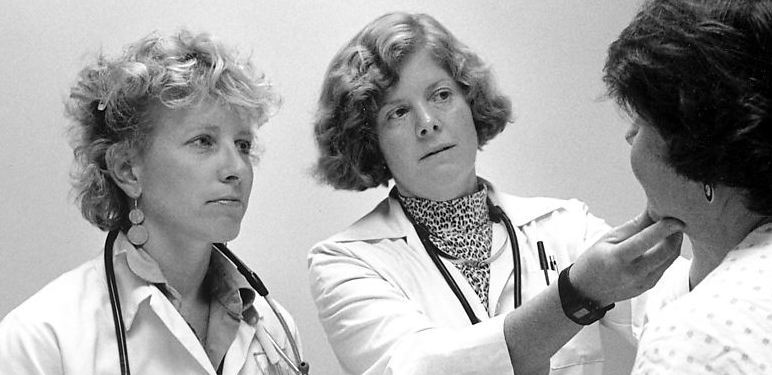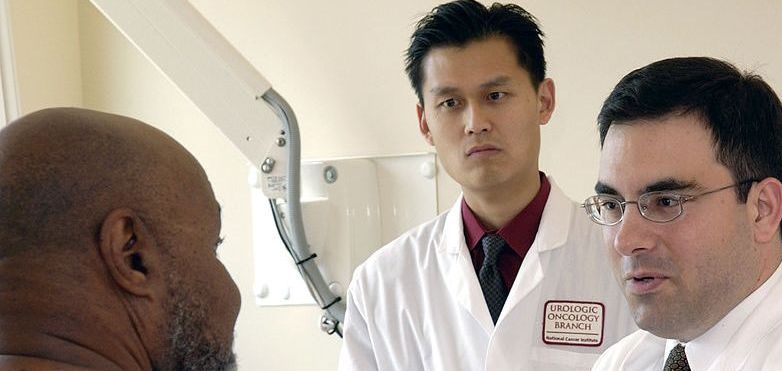 You’ve probably done this already or if you haven’t, you will: you sit in your doctor’s office and look at your doctor, your doctor sits at a desk and types on a computer. Your doctor apologizes for the lack of eye contact and explains something about health records now being electronic and tied to reimbursement. You hear “Electronic Health Records” and stop listening; it’s like “Health Policy” — who knows who makes that stuff or why.
You’ve probably done this already or if you haven’t, you will: you sit in your doctor’s office and look at your doctor, your doctor sits at a desk and types on a computer. Your doctor apologizes for the lack of eye contact and explains something about health records now being electronic and tied to reimbursement. You hear “Electronic Health Records” and stop listening; it’s like “Health Policy” — who knows who makes that stuff or why.
Your doctor complains about the non-intuitiveness and frustrating illogic of the program’s interface. You yourself know those bossy sites that force you through useless steps, sites on which you click five times on meaningless words to get one thing done; and you begin to sympathize, but it’s hard to express that without eye contact. Your doctor says these programs aren’t even interoperable, and then you remember the time you and your husband showed up for (minor but serious) surgery before dawn at the famous hospital and the hospital had no such surgery scheduled and had to call a surgeon out of bed; and later on, explained that your doctor’s computer and the hospital’s computer don’t talk to each other.
Your doctor, who is seriously pissed-off, winds up the office visit; she says she’s using an excellent medical education to do data entry and she’s spending more goddam time looking at the screen than at the patient. If you happen to have gone to more than one doctor in the past year or so, you’ll have heard this more than once. Everybody agrees that electronic health records are necessary and inevitable but a website devoted to them, reporting on a RAND study, says they’re causing the medical profession to have “high levels of disgruntlement.” No kidding.
 The issue of electronic health records has more branching side-issues than a whole forest: access to all records over time in one click; regulation and over-regulation of health care; the Affordable Care Act; software companies with competing products and great promises; and reports like the RAND report and then more reports, including one by the Jasons who more usually focus on nuclear test bans.
The issue of electronic health records has more branching side-issues than a whole forest: access to all records over time in one click; regulation and over-regulation of health care; the Affordable Care Act; software companies with competing products and great promises; and reports like the RAND report and then more reports, including one by the Jasons who more usually focus on nuclear test bans.
But at the moment I’m caught by an echo from one of Colin Norman’s splendid series: one of the reasons he initially neglected his potentially fatal aortic aneurysm was that his cardiologist spent little time with him, seemed uninterested. I can see this happening: one of my computer-locked doctors, though I’d seen him for decades, seemed at my last visit to be a little more remote and I was a little less interested in his advice.
I’m even more caught by something the pissed-off doctor above said. After complaining about the lacks of eye contact, a logical interface, and interoperability, she said, “and the worst is, I have to input numbers and facts. But I want to input narratives.”
I’ve been impressed by medicine’s basis in narratives ever since I went to an infectious disease case conference. The conferences happen once a week. A medical resident in a teaching hospital stands in front of an audience of residents, fellows, and attending physicians, all experts in infectious diseases, and describes a real patient: symptoms, medical history, lab test results, personal history, all the clues, everything but the diagnosis. The audience of young doctors asks questions and proposes diagnoses, they all vote, and the resident-in-charge tells them if they’re right or wrong. The day I went, the resident presented three patients and the infectious diseases doctors misdiagnosed all three. I was less impressed by the wrong diagnoses than by the presentation and the impossibility of dozing off during it: The patient is a 40-year old man who works in Yorkville in a restaurant. He had a stomach ache that wouldn’t go away. The pain eventually spread to his chest and his temperature was 103. His white blood cell count was normal. He began itching and his eyes swelled shut. His voice faded and failed. His next white cell count was dramatically elevated . . . *
I was at the case conference because I was profiling an infectious disease doctor, and now I’ll just let him talk: “It’s never easy at that conference and nobody gets it right all the time, even the pros. I like case conferences because I think people learn medicine best with an individual case that they’ve had to think about. I can go to a lecture on congestive heart failure and it would never make the impression that it would if I had to take care of a patient with congestive heart failure, because I can see it before my eyes. I have to be involved in it, I have to become a participant in the case. In the case conference, people are not passively learning, they become participants in the case. I think it’s the most effective learning tool in medicine.”
So the doctor — the watcher, like a writer — learns best by becoming a participant in the case. But the doctor isn’t interested only in learning; like a writer, the doctor has to end the story. Here’s the doctor again: “Don’t forget, the contest in infectious diseases is to figure out what the patient has. Once you figure it out, you can get the treatment out of a cookbook most of the time. But in ID, that’s the big dilemma: what bug is doing this? what has the patient got? It’s the difference between the art and the science of medicine. The science is the lab testing, the part that can be done by computer. The art of medicine is the art of medicine. It’s having that feeling, that touch, I don’t know, being a better detective, a better diagnostician. Every doctor starts with the same information but some of them get there better.”
That reminds me of a paramedic telling me she sometimes looked at a patient and wanted to yell, “What’s WRONG with you?” The virtues of electronic health records are obvious and the connection between doctors and computers isn’t going away any time soon. But you Health Policy makers, do you want good diagnosticians, good prescribers, doctors who “get there better”?
Then whoever you are, whoever’s making these policies, please listen. To get the patients to listen to the doctors, you’ll need to let the doctors make eye contact with them. And to let the doctors participate in whatever’s going wrong in the patient and figure out the story’s end, you’ll need to let them input narratives.
§
*Given the HIPAA regulations about patients’ privacy, I thought I’d better take this patient from Berton Roueché’s lovely collection, The Medical Detectives. The patient turned out to have trichinosis; this was 1942, it couldn’t be treated, he died. The doctors tracked down the infected pig.
_______
Photos: doctors with patient – Seattle Municipal Archives, via Wikimedia Commons; doctors with patient, National Cancer Institute, via Wikimedia Commons
What does it mean to input narratives? Do you just mean that the doctor should be writing a description of the patient and their case in the doctor’s own words, as opposed to filling out a form made of tick marks and drop down boxes?
I can see why that would be a nightmare for doctors, and why the people designing the programs and doing statistical analysis of medical records would want it that way.
That’s what I took the doctor to mean, Murray. And there are lots of good reasons to have electronic records. But right now the system ain’t working. One doctor I’ve met twice and still don’t know what he looks like because either he’s examining my eyes or his back is usually to me.